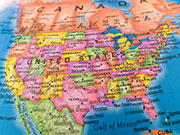- Skip Storing This Everyday Product in the Fridge Door
- Green Tea + B3 Pairing May Boost Brain Health
- Navigating Your Midlife Crisis: Embracing New Possibilities
- City Raccoons Showing Signs of Domestication
- Mapping the Exposome: Science Broadens Focus to Environmental Disease Triggers
- One Week Less on Social Media Linked to Better Mental Health
- Your Brain Changes in Stages as You Age, Study Finds
- Some Suicide Victims Show No Typical Warning Signs, Study Finds
- ByHeart Formula Faces Lawsuits After Babies Sickened With Botulism
- Switch to Vegan Diet Could Cut Your Greenhouse Gas Emissions in Half
Health Disparities Persist in America: Report


THURSDAY, Nov. 21Despite progress in some areas, health disparities remain for many Americans, health officials reported Thursday.
These inequalities are related to income, education, sex, race, ethnicity, employment and sexual orientation, and they all affect Americans’ health and well-being, according to the U.S. Centers for Disease Control and Prevention.
“The purpose of the report is to highlight disparities in health that still exist in the country,” said Dr. Chesley Richards, director of the CDC’s Office of Public Health Scientific Services, which produced the report.
“If you look at health in the country over the last 50 years, there has been a dramatic improvement in health,” he said. “We have seen an increase in life expectancy in the last 20 or 30 years.”
Across the 29 categories in the report there has been improvement, but many disparities persist, Richards said.
“For example, we have seen a decrease in tobacco use, but it’s not even. In people who have lower educational status, the disparity has actually widened — not improved,” he said.
“Although we have seen pretty dramatic improvement in health for the population overall, you really have to look at particular groups to see that there are still tremendous disparities in health outcomes,” Richards said.
The report is published in a Nov. 22 supplement to Morbidity and Mortality Weekly Report, a CDC publication.
The report covers a variety of areas, including disparities in deaths and illness, use of health care, lifestyle risk factors, environmental hazards and social aspects of health.
Key findings include the following:
- A dramatic drop occurred in the rate of teen births — by 18 percent from 2007 to 2010, with significant decreases seen among whites, blacks and Hispanics. There was substantial variation across states, from no significant change to a 30 percent reduction in Arizona.
- Hispanics, low wage earners, those with only a high school education, men and those born outside the United States are those most likely to take high-risk jobs — jobs where workers are likely to be injured or sickened.
- Binge drinking is more common among people aged 18 to 34, men, whites and people with higher household incomes.
- Despite a 58 percent drop in new cases of tuberculosis between 1992 and 2010, the disease remains disproportionately high among racial and ethnic minorities and those born outside the United States.
- Diabetes rates are higher among Hispanics and blacks than among Asians and whites. Higher rates are also seen among people without a college degree and who have lower household incomes.
- The infant death rate for blacks is more than double the rate for whites. The highest rates are in the South and Midwest.
- Men are nearly four times more likely to commit suicide than women, regardless of age, race or ethnicity. The highest rates for both men and women are among American Indians/Alaska Natives and whites.
- Cardiovascular disease is the leading cause of death in the United States, with blacks at least 50 percent more likely to die of heart disease or stroke prematurely than whites.
The report also covers 10 new areas involving health disparity. These are: access to healthy foods, activity limitations due to chronic diseases, asthma attacks, fatal and nonfatal work-related injuries and illnesses, health-related quality of life, gum disease in adults, living close to major highways, tuberculosis and unemployment.
It also highlights the need to collect more consistent health data that have been lacking in surveys, such as disability and sexual orientation, the authors noted.
“This report is a timely reminder that the United States has vast resources that are very unevenly distributed,” said Dr. David Katz, director of the Yale University Prevention Research Center.
“We have huge disparities in health, because we have huge disparities in everything from income to education,” he said.
Katz said that health care reform must extend beyond the doctor’s office and hospital.
“We will best eliminate health disparities not by improving disease care, but by improving equity,” he said.
More information
To find out more about health disparities, visit the U.S. National Library of Medicine.
Source: HealthDay
Copyright © 2025 HealthDay. All rights reserved.










